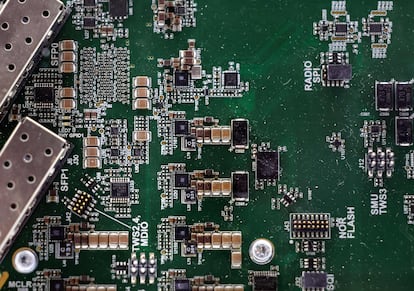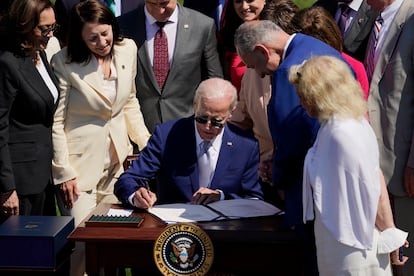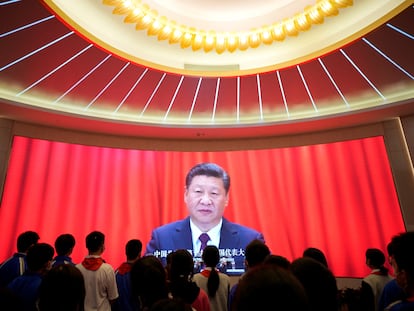The CHIPS and Science Act: What you need to know about Joe Biden’s new law
Washington plans to reduce the country’s dependence on foreign manufacture of semiconductors and create employment opportunities for its citizens

The United States is betting on the domestic manufacturing of microchips. With that in mind, last August President Joe Biden signed the CHIPS (Creating Helpful Incentives to Produce Semiconductors) and Science Act into law, an initiative that seeks to eradicate, on several fronts, some discomforts that the country has been dragging. The guiding principle of this measure revolves around the local production of semiconductors – also known as microchips – necessary for the manufacture of digital or electronic devices such as cell phones, computers and cars.
This legislation is backed by a total investment of $280 billion, of which $52 billion are intended to be allocated to the construction and expansion of plants and factories for these components. A total of $100 billion would be earmarked for semiconductor research and development over the next five years. This approach seeks to strengthen the national technology sector as a defense strategy, avoiding dependence on the international market in this field and creating employment opportunities; it is also an effort to catch up with China, the main competitor in the technology sector on a global scale.

Dealing with the global chip shortage
The Covid-19 health crisis brought the global semiconductor production cycle to a halt, leaving the automotive, smartphone and computer industries at the expense of the available reserves. The effect this had on the American manufacturing chain confirmed what the experts had been predicting about the national and international economic machinery’s dependence on this crucial component.
Reduce the dependence on Taiwan
Quite quietly, Taiwan has been gaining ground as the world’s leading chipmaker, currently producing about 25% of all semiconductors on the planet. It is precisely this resource what has led to new debates about their intentions and what lies behind the recent trade confrontations and the constant military threats between the great powers, China and the United States.
A stop to the Chinese threat
The United States significantly reduced its semiconductor production over the past thirty years. In the 1990s, it produced 37% of all the chips used in the country; currently, it is responsible for 12%, according to data from the Semiconductor Industry Association. Companies that were involved in their production gradually left the country to settle mainly in Asia, where they found advantages in production costs.
China was the main beneficiary of this industrial migration, leaving the United States with minimal assembly work. The Biden administration proposes to take advantage of the CHIPS and Science Act not only to deal with the shortage, but also to keep the production cycle within the country, avoiding as far as possible the dependence on foreign (mainly Asian) companies.
Sign up for our weekly newsletter to get more English-language news coverage from EL PAÍS USA Edition
Tu suscripción se está usando en otro dispositivo
¿Quieres añadir otro usuario a tu suscripción?
Si continúas leyendo en este dispositivo, no se podrá leer en el otro.
FlechaTu suscripción se está usando en otro dispositivo y solo puedes acceder a EL PAÍS desde un dispositivo a la vez.
Si quieres compartir tu cuenta, cambia tu suscripción a la modalidad Premium, así podrás añadir otro usuario. Cada uno accederá con su propia cuenta de email, lo que os permitirá personalizar vuestra experiencia en EL PAÍS.
¿Tienes una suscripción de empresa? Accede aquí para contratar más cuentas.
En el caso de no saber quién está usando tu cuenta, te recomendamos cambiar tu contraseña aquí.
Si decides continuar compartiendo tu cuenta, este mensaje se mostrará en tu dispositivo y en el de la otra persona que está usando tu cuenta de forma indefinida, afectando a tu experiencia de lectura. Puedes consultar aquí los términos y condiciones de la suscripción digital.
More information
Archived In
Últimas noticias
Most viewed
- Sinaloa Cartel war is taking its toll on Los Chapitos
- Oona Chaplin: ‘I told James Cameron that I was living in a treehouse and starting a permaculture project with a friend’
- Reinhard Genzel, Nobel laureate in physics: ‘One-minute videos will never give you the truth’
- Why the price of coffee has skyrocketed: from Brazilian plantations to specialty coffee houses
- Silver prices are going crazy: This is what’s fueling the rally











































